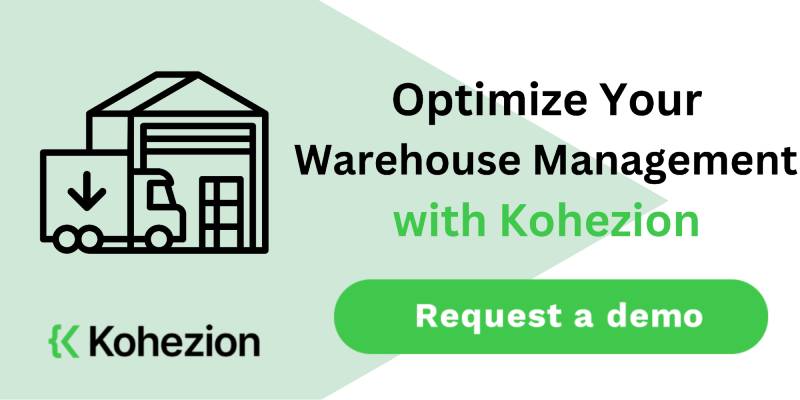Did you know that using warehouse optimization software can boost efficiency by up to 30%? Today, businesses face the challenge of managing inventory and logistics. They're looking for effective warehouse optimization tools more than ever. In 2024, companies are embracing advanced solutions for better operations, labor management, and inventory control.
This guide showcases the top 20 software options for this year. You'll learn how these tools make processes smoother, automate tasks, and save resources. This ensures you're ready for the competitive future ahead.
What Is Warehouse Optimization Software?
Warehouse optimization software is a set of advanced tools aimed at making warehouse operations more efficient. It uses artificial intelligence (AI) and machine learning (ML) to boost efficiency in managing inventory, fulfilling orders, and predicting demand.
This software acts as a key tool for streamlining daily tasks. It analyzes both past data and current trends to improve productivity and accuracy. The benefits of warehouse software include better productivity and accuracy thanks to its smart analytics and real-time monitoring.
Why Is Warehouse Optimization Software Important?
Warehouse management software changes the game for businesses in eCommerce and supply chain management. It makes processes smoother, giving companies a competitive edge. This software boosts efficiency in warehouses, helping them meet market demands quickly.
It optimizes warehouse layouts and workflows, leading to quicker order fulfillment and fewer mistakes. The benefits go beyond just speed; they also mean lower costs. Efficient warehouses manage inventory better, reducing errors and improving resource use.
As logistics get more complex, optimization software becomes key. Companies that use it cut down on manual tasks and boost productivity. With warehouse management solutions, businesses can meet customer needs better, leading to more repeat customers.
Benefits of Warehouse Optimization Software
Using warehouse optimization software brings many advantages. It changes how you handle your resources and processes. It's key to making your warehouse more efficient and reaching your goals.
Increased Efficiency
Warehouse optimization software automates everyday tasks. This lets your team focus on important warehouse tasks. It cuts down processing times a lot.
Improved Inventory Management
It also makes managing inventory better with automatic tracking and reports. You get real-time updates on stock levels. This helps avoid overstocking and running out of items, keeping the flow of products smooth.
Enhanced Accuracy
Barcode scanning cuts down on errors from manual data entry. This means your inventory and orders are more accurate. Happy customers are the result.
Reduced Operational Costs
When you streamline your operations and use labor more efficiently, you save money. Better inventory management also helps reduce costs. This makes it easier to use your resources well.
Better Space Utilization
Optimization software helps plan and use space better in your warehouse. You can store more without expanding physically. This is a big plus.
Faster Order Fulfillment
Automation makes processing and shipping orders quicker. Faster fulfillment means quicker delivery times. Happy customers stick around and buy more.
Improved Labor Productivity
It also helps manage your team better, so they can meet demand without getting overwhelmed. This keeps your team productive and happy.
Real-Time Data Insights
Management gets real-time analytics for better decisions. This leads to ongoing improvement in how you run things and serve customers.
Enhanced Customer Satisfaction
On-time deliveries and accurate orders make customers happy. Happy customers stay loyal and keep buying from you.
Scalability and Flexibility
The software grows with your business. It adapts to more inventory or new locations easily.
Streamlined Processes
Automation cuts downtime and makes things simpler. This means smoother workflows. It also helps you use resources better.
Improved Supply Chain Management
It helps your supply chain partners work better together. This leads to smoother operations in your warehouse and across the supply chain.
Reduced Human Error
Automation means less manual work, which means fewer mistakes. This is key for keeping things running smoothly and building trust with customers.
Better Resource Allocation
Managing resources well means everything runs smoothly in your warehouse. This approach boosts productivity and cuts waste.
Increased Competitive Advantage
Using optimization software puts you ahead of competitors who don't use it. This edge can lead to a stronger market presence and success.

20 Best Warehouse Optimization Software
Below are the top 20 warehouse optimization software of our choice.
1. Kohezion

Kohezion is a powerful, customizable warehouse management software designed to streamline your inventory processes and enhance operational efficiency. With its intuitive interface, Kohezion allows businesses to tailor the system to their specific needs, providing real-time visibility into inventory levels and warehouse operations. This cloud-based solution ensures data accessibility and security, making it ideal for businesses of all sizes.
Top 5 Features:
- Customizable dashboards and reports
- Real-time inventory tracking
- Integration with major eCommerce platforms
- Mobile access for on-the-go management
- Automated alerts and notifications
Benefits:
- Improved inventory accuracy
- Enhanced operational efficiency
- Scalability to grow with your business
Cons:
- Steeper learning curve for complex customizations
- Limited offline functionality
Best For: Large businesses seeking a highly customizable and scalable warehouse management solution.

2. Epicor

Epicor WMS is designed to optimize warehouse operations, improve inventory accuracy, and enhance overall supply chain efficiency. This comprehensive solution integrates seamlessly with Epicor ERP systems, providing real-time data visibility and advanced functionalities for effective warehouse management.
Top 5 Features:
- Real-Time Inventory Tracking
- Automated Data Collection
- Advanced Shipping and Receiving
- Dynamic Slotting
- Comprehensive Reporting and Analytics
Benefits:
- Improved warehouse efficiency
- Enhanced inventory accuracy
- Seamless integration with ERP system
Cons:
- High implementation and maintenance costs
- Complexity of customization
Best For: Medium to large enterprises seeking an integrated warehouse management and ERP solution.
3. Fishbowl

Fishbowl is a robust solution designed to streamline inventory management and warehouse operations for businesses of all sizes. It integrates seamlessly with QuickBooks, providing enhanced control over inventory, order management, and warehouse efficiency..
Top 5 Features:
- Multi-Location Inventory Management
- Order management
- Barcode Scanning
- Integration with QuickBooks
- Advanced Reporting
Benefits:
- Improved inventory accuracy
- Streamlined manufacturing processes
- Enhanced financial management
Cons:
- Learning Curve
- Limited customer support options
Best For: Small to mid-sized manufacturers looking for an integrated inventory and manufacturing management solution.
4. Interlake WMS

Interlake WMS is designed to optimize and streamline warehouse operations, providing efficient management of inventory, orders, and overall warehouse workflow. This software aims to enhance productivity, reduce errors, and ensure accurate inventory tracking through advanced technology and user-friendly features..
Top 5 Features:
- Inventory tracking and management
- Order processing and fulfillment
- Warehouse automation support
- Real-time data and analytics
- Integration with eCommerce platforms
Benefits:
- Improved order accuracy
- Enhanced operational efficiency
- Streamlined warehouse operations
Cons:
- Higher subscription costs
- Limited customization options
Best For: eCommerce businesses looking for a specialized warehouse management solution with strong automation features.
5. ShipHero
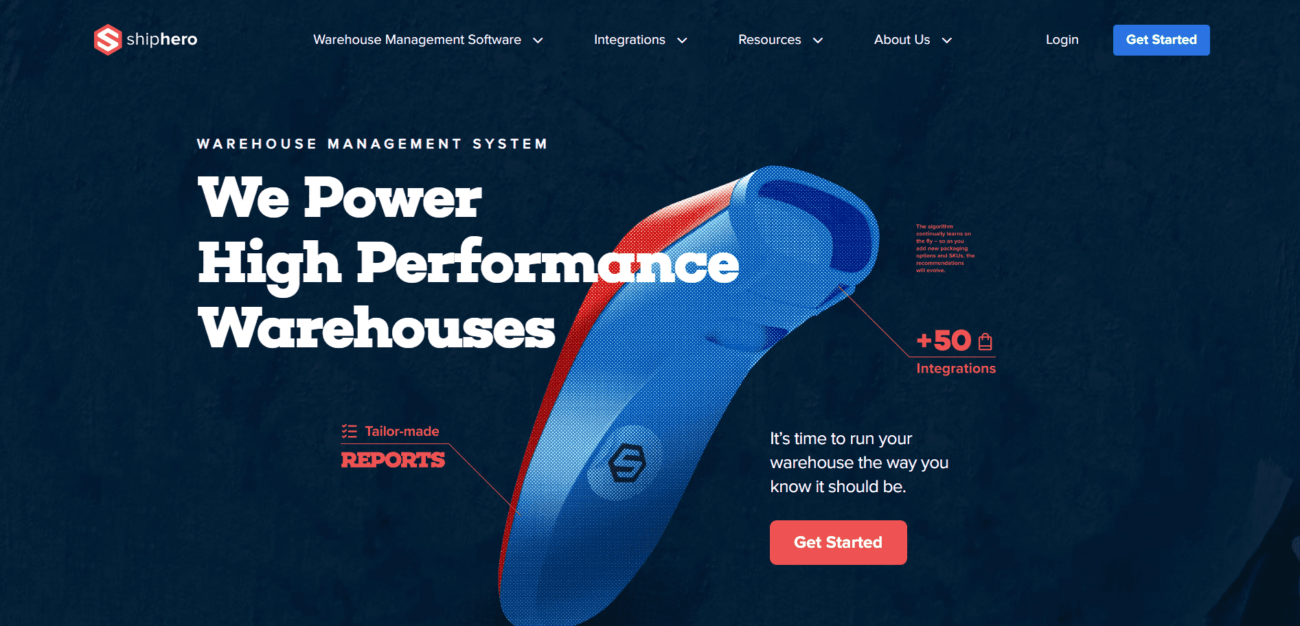
ShipHero is a comprehensive solution designed to streamline eCommerce and retail warehouse operations. It focuses on enhancing order fulfillment efficiency, inventory accuracy, and overall warehouse productivity. ShipHero integrates seamlessly with various eCommerce platforms, providing a robust toolset for managing warehouse activitie.
Top 5 Features:
- Inventory tracking and management
- Order processing and fulfillment
- Shipping automation
- Real-time data and analytics
- Integration with eCommerce platforms
Benefits:
- Improved order accuracy
- Enhanced operational efficiency
- Streamlined shipping processes
Cons:
- Higher subscription costs
- Learning Curve
Best For: eCommerce businesses looking for a specialized warehouse management solution with strong shipping automation features.
6. Blue Yonder

Blue Yonder is a solution designed to optimize warehouse operations, improve inventory accuracy, and enhance overall supply chain efficiency. This software leverages advanced technologies, such as artificial intelligence and machine learning, to provide real-time insights and automation capabilities, making it suitable for businesses of all sizes.
Top 5 Features:
- AI and Machine Learning
- Real-Time Inventory Visibility
- Order Fulfillment Optimization
- Labor Management
- Integration Capabilities
Benefits:
- Enhanced warehouse efficiency
- Improved inventory accuracy
- Better labor utilization
Cons:
- High implementation and maintenance costs
- Complexity of customization
Best For: Large enterprises with advanced warehouse management needs and a focus on analytics.
7. SkuVault Core

SkuVault Core is a powerful warehouse management software designed to help businesses streamline their inventory and warehouse operations. It offers a range of features to enhance inventory accuracy, reduce out-of-stock issues, and improve overall operational efficiency.
Top 5 Features:
- Barcode scanning
- Order syncing with eCommerce platforms
- Inventory forecasting
- Multi-warehouse management
- Quality control tools
Benefits:
- Reduced order errors
- Enhanced inventory visibility
- Streamlined multi-channel operations
Cons:
- Dependency on Internet
- May require third-party integrations for full functionality
Best For: eCommerce businesses needing robust inventory management and multi-warehouse support.
8. Manhattan SCALE
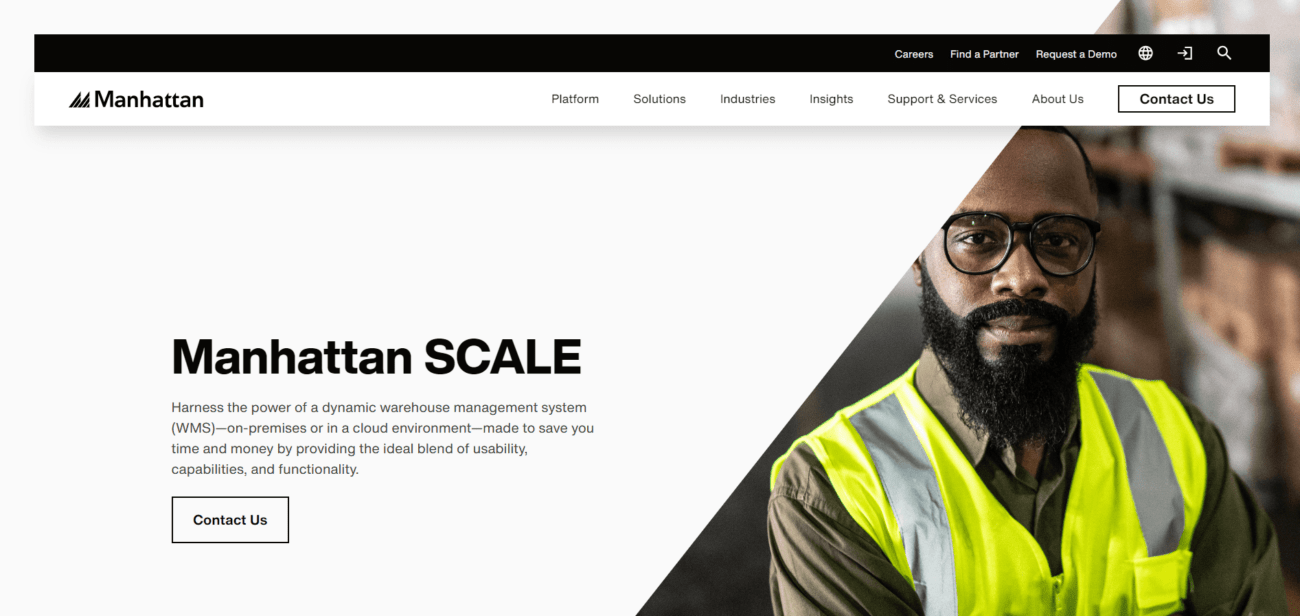
Manhattan SCALE is a scalable warehouse management system that provides comprehensive tools for optimizing warehouse operations. It offers features for inventory management, order processing, and labor management, all designed to enhance warehouse efficiency. Manhattan SCALE is known for its flexibility and ability to adapt to changing business needs.
Top 5 Features:
- Inventory tracking and management
- Advanced order processing
- Labor management and optimization
- Real-time data and analytics
- Integration with supply chain systems
Benefits:
- Improved warehouse efficiency
- Enhanced inventory accuracy
- Flexibility to adapt to business changes
Cons:
- High implementation and maintenance costs
- Steep learning curve
Best For: Medium to large enterprises seeking a flexible and scalable warehouse management solution.
9. Infor WMS

Infor WMS is a highly configurable warehouse management system designed to optimize warehouse operations and improve efficiency. It provides robust features for inventory control, order fulfillment, and warehouse automation. Infor WMS supports multi-site operations, making it ideal for businesses with multiple warehouse locations.
Top 5 Features:
- Real-time inventory visibility
- Advanced order fulfillment
- Warehouse automation support
- Multi-site management
- Integration with Infor ERP systems
Benefits:
- Enhanced operational efficiency
- Improved inventory accuracy
- Scalability for multi-site operations
Cons:
- High implementation costs
- Steep Learning Curve
Best For: Medium to large enterprises with multiple warehouse locations and advanced warehouse management needs.
10. SAP Extended Warehouse Management

SAP Extended Warehouse Management (EWM) is a powerful warehouse management system designed for large enterprises with complex supply chain needs. It offers extensive functionality for managing high-volume warehouse operations, including inventory control, order fulfillment, and labor management. SAP EWM integrates seamlessly with other SAP modules, providing a holistic approach to supply chain management.
Top 5 Features:
- Advanced inventory management
- Labor management and optimization
- Warehouse automation integration
- Real-time data and analytics
- Seamless integration with SAP ERP
Benefits:
- Improved warehouse efficiency
- Enhanced inventory accuracy
- Reduced labor costs
Cons:
- High implementation and maintenance costs
- Complex Configuration
Best For: Large enterprises with complex warehouse operations and existing SAP infrastructure.
11. Logiwa

Logiwa is an intuitive warehouse management software designed for small to mid-sized businesses. It offers streamlined solutions for managing inventory, order fulfillment, and warehouse operations, with a focus on enhancing efficiency and accuracy.
Top 5 Features:
- Inventory tracking and management
- Order processing and fulfillment
- Warehouse automation support
- Real-time data and analytics
- Integration with eCommerce platforms
Benefits:
- Improved order accuracy
- Enhanced operational efficiency
- Streamlined warehouse operations
Cons:
- Limited Advanced Features
- Customization Constraints
Best For: eCommerce businesses looking for a specialized warehouse management solution with strong automation features.
12. Oracle NetSuite

Oracle NetSuite is an integrated solution designed to enhance the efficiency and accuracy of warehouse operations. Part of the broader NetSuite ERP suite, it provides businesses with advanced tools for inventory management, order fulfillment, and supply chain optimization.
Top 5 Features:
- Real-time inventory visibility
- Automated order management
- Advanced shipping and receiving
- Multi-location inventory management
- Integration with other NetSuite ERP modules
Benefits:
- Enhanced decision-making with real-time data
- Streamlined operations through automation
- Scalability for growing businesses
Cons:
- High implementation costs
- Complexity of customization
Best For: Medium to large enterprises seeking a comprehensive, scalable ERP solution with advanced warehouse management capabilities.
13. 3LP Warehouse Manager by Extensis
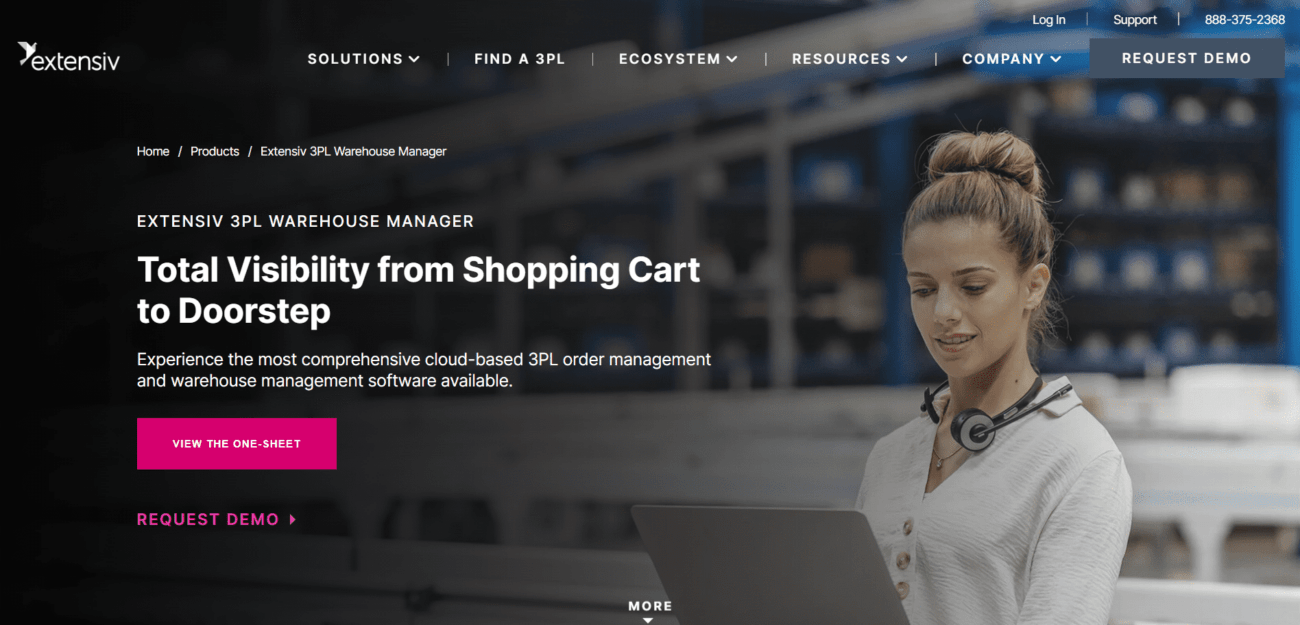
3PL Warehouse Manager is a comprehensive warehouse management system designed to optimize and streamline warehouse operations. Tailored for third-party logistics (3PL) providers and businesses with complex warehousing needs, it offers robust tools to enhance efficiency, accuracy, and control across various warehouse activities.
Top 5 Features:
- Multi-client inventory management
- Order processing and fulfillment
- Billing and invoicing
- Real-time reporting and analytics
- Integration with eCommerce platforms
Benefits:
- Improved client management
- Enhanced operational efficiency
- Streamlined billing processes
Cons:
- Maintenance and Support Costs
- Performance Issues with High Volume
Best For: Third-party logistics providers looking for a specialized warehouse management solution.
14. Gramener
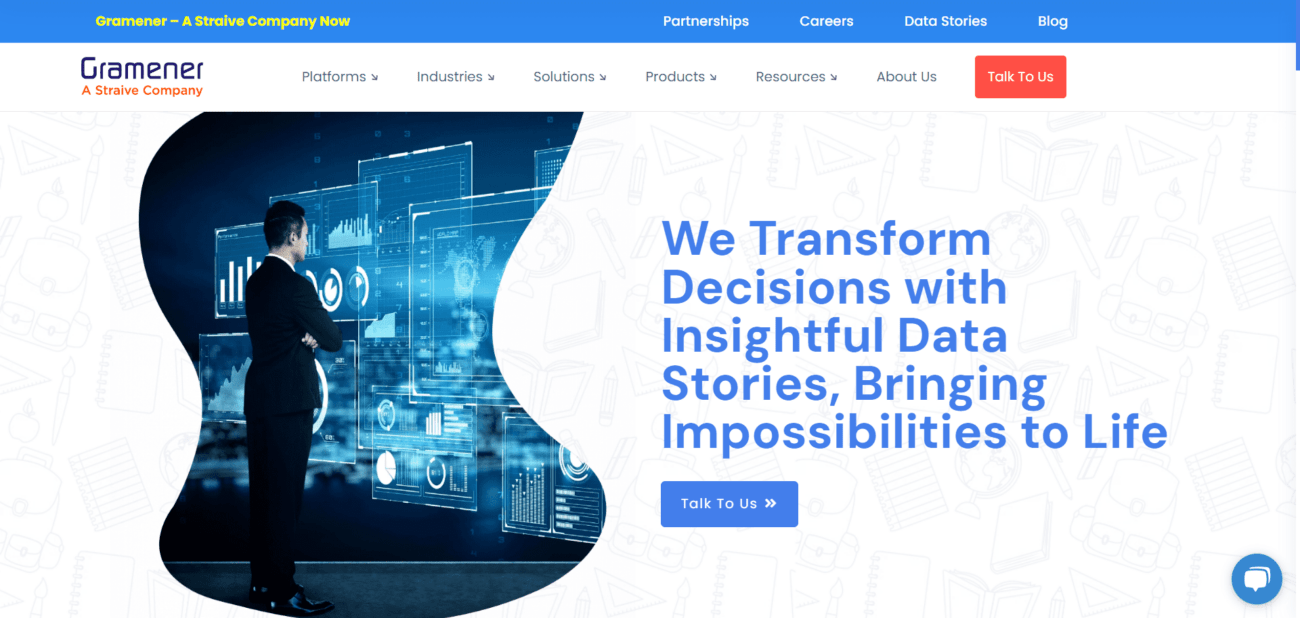
Gramener offers a data-driven approach to optimizing warehouse operations. It leverages advanced analytics and visualization tools to enhance inventory management, order fulfillment, and overall efficiency within the warehouse.
Top 5 Features:
- Inventory tracking and management
- Order processing and fulfillment
- Warehouse automation support
- Real-time data and analytics
- Machine learning-driven insights
Benefits:
- Improved warehouse efficiency
- Enhanced inventory accuracy
- Data-driven decision-making
Cons:
- Dependence on Data Quality
- Complexity of customization
Best For: Medium to large enterprises seeking a data-driven warehouse management solution with advanced analytics.
15. Zoho Inventory

Zoho Inventory is a cloud-based inventory management system designed for small to medium-sized businesses. It provides tools for inventory tracking, order management, and warehouse management. Zoho Inventory integrates seamlessly with other Zoho applications, providing a comprehensive solution for managing business operations.
Top 5 Features:
- Inventory tracking and management
- Order processing and fulfillment
- Warehouse automation support
- Real-time data and analytics
- Integration with Zoho applications
Benefits:
- Improved inventory accuracy
- Enhanced operational efficiency
- Seamless integration with Zoho applications
Cons:
- Limited advanced features
- Higher costs for additional modules
Best For: Small to medium-sized businesses looking for an integrated inventory and warehouse management solution within the Zoho ecosystem.
16. Körber
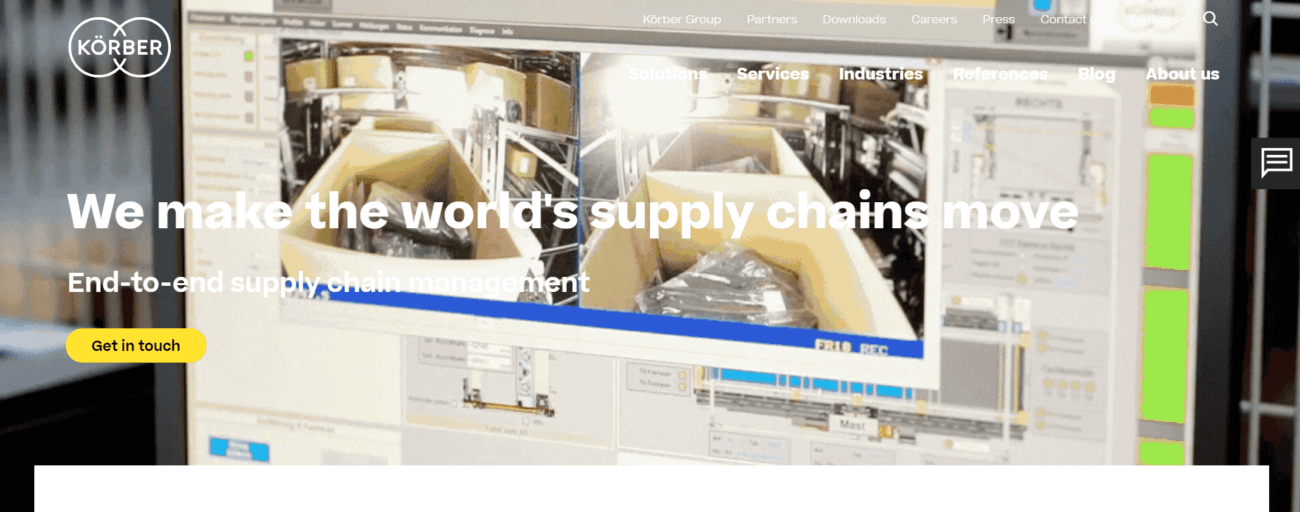
Körber offers a robust warehouse management system that helps businesses streamline their warehouse operations and improve efficiency. The system provides tools for inventory management, order fulfillment, and warehouse automation, all designed to optimize warehouse processes. Körber's WMS is known for its flexibility and ability to integrate with various supply chain systems.
Top 5 Features:
- Inventory tracking and management
- Order processing and fulfillment
- Warehouse automation support
- Real-time data and analytics
- Integration with supply chain systems
Benefits:
- Improved operational efficiency
- Enhanced inventory accuracy
- Flexibility to adapt to business changes
Cons:
- High implementation and maintenance costs
- Complexity of customization
Best For: Medium to large enterprises seeking a flexible and comprehensive warehouse management solution.
17. Infoplus

Infoplus is a cloud-based warehouse management system designed to help businesses optimize their warehouse operations and improve efficiency. It provides tools for inventory management, order fulfillment, and warehouse automation. Infoplus integrates seamlessly with popular eCommerce platforms and marketplaces, providing a comprehensive solution for managing warehouse operations and fulfilling orders.
Top 5 Features:
- Inventory tracking and management
- Order processing and fulfillment
- Warehouse automation support
- Real-time data and analytics
- Integration with eCommerce platforms
Benefits:
- Improved order accuracy
- Enhanced operational efficiency
- Streamlined warehouse operations
Cons:
- Higher subscription costs
- Limited customization options
Best For: eCommerce businesses looking for a specialized warehouse management solution with strong automation features.
18. Magaya WMS

Magaya WMS is a warehouse management software designed to streamline and optimize warehouse operations. It provides tools for inventory control, order fulfillment, and logistics management, aimed at enhancing operational efficiency and accuracy for businesses of various sizes.
Top 5 Features:
- Inventory Management
- Order processing and fulfillment
- Integrated Logisticsrt
- Real-time data and analytics
- Barcode Scanning
Benefits:
- Improved warehouse efficiency
- Enhanced inventory accuracy
- Seamless integration with other supply chain solutions
Cons:
- High implementation and maintenance costs
- Limited customization options
Best For: Small to medium-sized businesses looking for an integrated warehouse management and supply chain solution.
19. Inovity

Inovity provides a comprehensive solution for optimizing warehouse operations. Designed for various business sizes, it focuses on improving inventory management, order fulfillment, and overall warehouse efficiency through automation and real-time data insights.
Top 5 Features:
- Real-Time Inventory Tracking
- Order Fulfillment Automation
- Barcode and RF Scanning
- Customizable Dashboards
- Integration with eCommerce platforms
Benefits:
- Improved order accuracy
- Enhanced operational efficiency
- Streamlined warehouse operations
Cons:
- Customization Limits
- Complex Setup
Best For: eCommerce businesses looking for a specialized warehouse management solution with strong automation features.
20. Peoplevox WMS

Peoplevox WMS is a cloud-based warehouse management software designed to streamline and enhance warehouse operations. It provides a user-friendly interface and robust functionality to manage inventory, order fulfillment, and logistics, aimed at improving efficiency and accuracy for eCommerce businesses and other organizations.
Top 5 Features:
- Real-Time Inventory Visibility
- Order Fulfillment Automation
- Barcode Scanning
- Customizable Workflows
- Integration with eCommerce platforms
Benefits:
- Improved order accuracy
- Enhanced operational efficiency
- Streamlined warehouse operations
Cons:
- Higher subscription costs
- Limited customization options
Best For: eCommerce businesses looking for a specialized warehouse management solution with strong automation features.
Key Features to Look for in a Warehouse Optimization Software
When looking for the right software to improve your warehouse, think about features that make things run smoother and faster. These features help you manage inventory, fill orders, and use space well. Here are some important parts to look for in a top warehouse optimization system.
Inventory Management
A strong inventory system lets you keep track of stock in real-time and automatically order more when needed. This is key to keeping enough stock on hand.
Order Management
Good order management tools help you keep an eye on orders and ship them out fast. This means you can meet customer needs quickly, making your order process better.
Space Utilization
Being able to plan your warehouse layout helps you in using space well and cutting down on movement. This is a main feature to look for in a warehouse optimization system.
Labor Management
Keeping an eye on how workers perform and planning for staff needs can boost productivity. Tools that track how well the workforce is doing are key for managing a warehouse well.
Automated Reporting
Automated reports make it easy to check on how things are doing, giving you important insights without a lot of work.
Barcode Scanning
Using barcode scanners, whether mobile or fixed, helps keep inventory accurate and makes tracking easier.
Real-Time Analytics
Choose software that gives you real-time data so you can make quick changes and keep things running smoothly.
Integration Capabilities
Being able to work well with your current systems like ERP and eCommerce will provide a smooth operation.
Advanced Forecasting
Using advanced analytics to predict inventory needs based on past sales is key for good planning.
Order Picking Optimization
Features that make picking orders faster can greatly reduce how long it takes to fulfill orders, which makes customers happier.
Receiving and Shipping Management
Handling both incoming and outgoing shipments well can make your supply chain run smoother.
Security Features
Protecting inventory and customer data with strong security is very important.
Mobile Accessibility
A system that works well on mobile devices lets users check important info anywhere, making management easier.
Customizable Workflows
Being able to adjust workflows to fit your business needs can make operations run better.
Scalability
Make sure the software can grow with your business, handling more complexity and volume as you get bigger.
Thinking about these features will help you pick a warehouse optimization solution that meets your needs now and in the future.

How To Implement a Warehouse Optimization Software
Starting with warehouse optimization software needs a step-by-step plan for a smooth change and good use. Each step is key to making things run better and reaching your goals.
Assess Current Operations
First, look at how things are done now. Find out what slows things down, how resources are used, and what needs to get better. Knowing this helps you make smart choices later.
Define Objectives and Requirements
Set clear goals for success. Decide what the software must do to help your business. This makes picking the right software easier and ensures it meets your needs.
Select the Right Software
Look at different warehouse optimization tools. Focus on things like managing stock, fulfilling orders, and working with your current systems. Choosing the best one means comparing options to find the best match for your business.
Plan the Implementation Process
List all the steps, what you need, and when things will happen. This careful planning helps everything go smoothly and the new software fit in well.
Prepare the Infrastructure
Check if your setup, like computers and internet, can handle the software's needs. Getting ready in advance makes sure the software works well once it's live.
Data Migration
Moving data from old systems to the new one is a big step. Plan it carefully to keep data safe and right, and to avoid disrupting work.
System Configuration and Customization
After moving data, set up and tailor the software to your business's needs. This makes sure it works well and meets your warehouse's specific needs.
Integrate with Existing Systems
Make sure the new software works well with your current systems. This ensures better data flow and communication between different parts of your business.
Test the System
Test the system before it goes live. Find and fix any problems to make sure everything works as it should. This is key for a successful start.
Train the Staff
Give your staff the skills and knowledge they need to use the system well. This will boost productivity and efficiency.
Go Live
When everything is ready, start using the new system. Make sure important people know what to expect and are ready to solve any problems that come up.
Monitor and Evaluate Performance
Keep an eye on how the software is doing after it's in use. Look at important numbers to see if it's meeting your goals and find areas to improve.
Gather Feedback and Make Improvements
Ask staff and stakeholders for their thoughts on the system. Use their feedback to make changes that make it better and more useful.
Regular Maintenance and Updates
Keeping the software up to date is key to its success. Plan regular updates to keep it secure and with the latest features.
Review and Optimize Continuously
Make it a habit to check and improve your warehouse processes regularly. Always look at how the software helps your operations and be ready to make changes as needed.
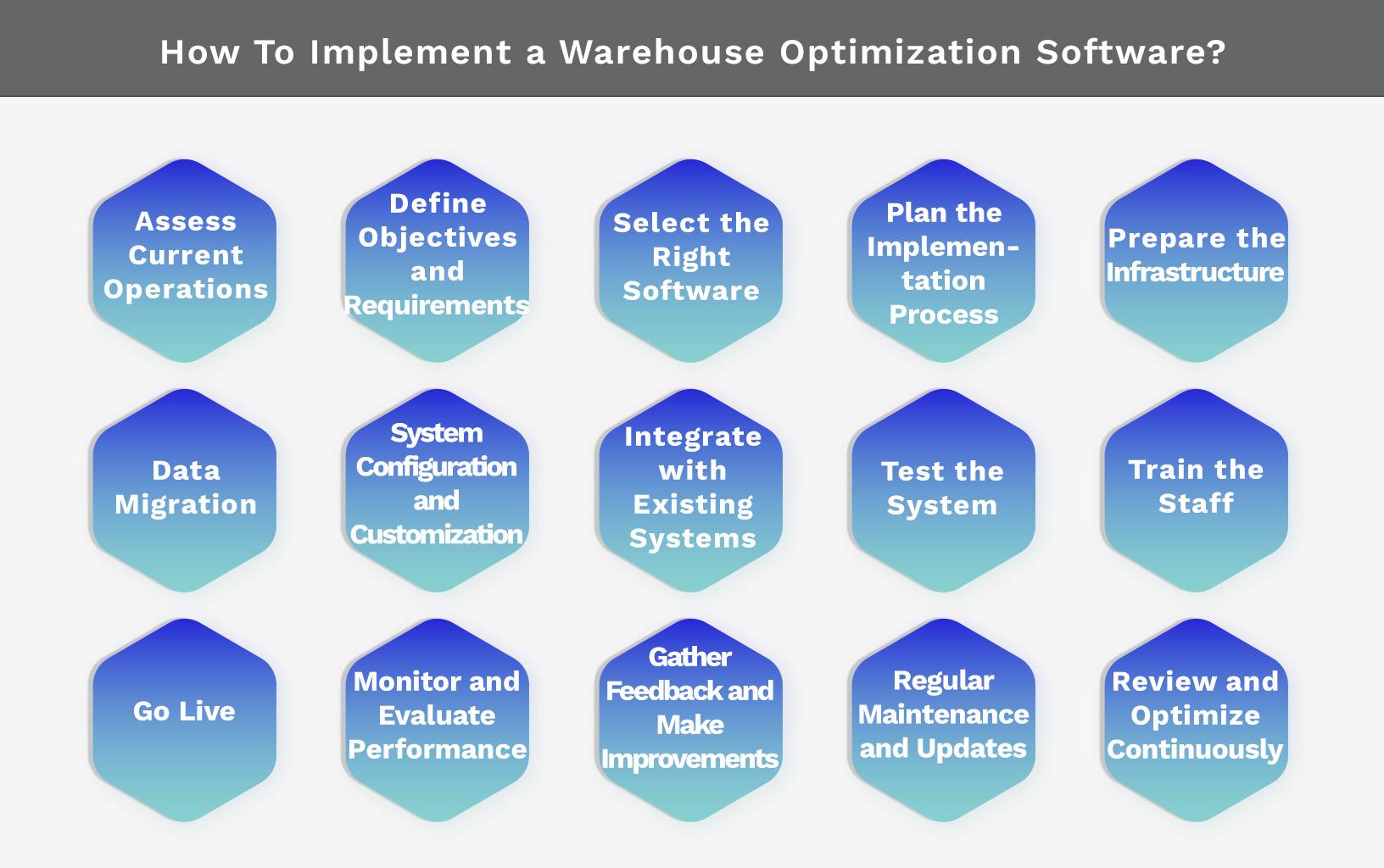
Optimize Your Warehouse Management with Kohezion
To make your warehouse run smoothly, it's key to use the right software solutions for warehouses. Kohezion is a top choice for boosting efficiency in warehousing with its wide range of features.
This platform has easy-to-use tools that help track inventory better and speed up order fulfillment. With customizable dashboards and real-time analytics, Kohezion helps you make smart decisions. This ensures you can manage your warehouse well.
Key features of Kohezion include:
- Enhanced inventory tracking.
- Automated demand forecasting.
- Effective appointment scheduling.
- Resource allocation improvements.
- Maximized storage space.
Using Kohezion can make important tasks easier and boost your performance. The software works well with other apps, making sure information flows smoothly across your business.
Adding Kohezion can make you more responsive to market needs and increase customer happiness. This puts your business ahead in the competition. It's a key tool for those looking to greatly improve warehouse efficiency.
Conclusion
In today's fast-paced logistics world, using warehouse optimization software is key. It boosts efficiency and helps manage inventory better. This software makes processes smoother, cuts down on mistakes, and helps use resources wisely.
As customers want more and competition grows, having the right tools is a must to stay ahead. The guide to the best software for 2024 is a great help. It lets you pick tools that fit your needs and goals.
Keeping up with new warehouse optimization strategies and tools helps your business to grow and make customers happy. When looking for the right software, remember it can greatly improve your business's efficiency. This could be the key to success in the logistics field.
Start building with a free account
Frequently Asked Questions
Yes, many software solutions offer scalable options that can be tailored to meet the needs of small businesses, providing essential tools to improve efficiency without the need for a large investment.
The implementation timeline can vary depending on the complexity of the software and the size of the warehouse, but it typically ranges from a few weeks to several months.
Yes, many solutions offer customization options to address industry-specific requirements, ensuring that the software aligns with unique operational needs and processes.
